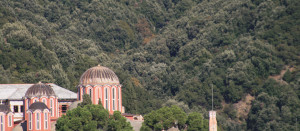
Impire Basil I den Byzantine bestowed na manaigh a bhfuil an ceart sin amháin mbealach isteach chuig an leithinis Mount Athos i 885 A.D. Tá siad tógtha pobal reiligiúnach borradh agus a chothabháil agus a chosaint ar an éiceachóras ó shin i leith. Cúrsaí bainisteoireachta Is éard atá den chuid is mó a rialú iontrála agus rialú cleachtais adhmaid. Aithnítear an leithinis go hoifigiúil mar Shuíomh Oidhreachta Domhanda UNESCO agus mar Natura 2000 láithreán, ach níor cuireadh an dá ainmniúchán ar bun le dul i gcomhairle leis na manaigh. Mar sin féin, i 1926 d'aithin bunreacht na Gréige go raibh na manaigh freagrach go hiomlán as bainistiú an tsuímh.
Tá fiche mainistreach san iomlán ar shuíomh Chríostaíocht Cheartchreidmheach an Oirthir. Tugann na manaigh tábhacht spioradálta d’éiceachóras an tsléibhe agus feiceann siad é a chosaint mar a gcuspóir diaga. Tá na mainistreacha féin-leordhóthanach ina gcuid riachtanas fuinnimh freisin agus táirgeann siad cuid dá gcuid bia agus leigheas luibhe féin. Oibríonn na mainistreacha uathrialacha chun an nádúr a chosaint faoi threoir comhar ar a dtugtar an Comhphobal Naofa.

Tá an mhainistir seo suite i gcúl chúlra cnoic lena n-áirítear foraoisí Holm agus Darach Ungáiris. Ní hamháin go bhfuil tábhacht éiceolaíochta ag baint leis na foraoisí sin, ach foráiltear freisin in ábhair thógála a bhfuil géarghá leo agus ioncam eacnamaíoch do na pobail mhainistreacha ar Mt. Athos
Oibríonn na manaigh i gcomhar le heolaithe chun eolas a fháil ar bhagairtí éiceachórais a bhaineann go sonrach leis an suíomh ar nós tinte fiáine agus díothacht ithreach.. Mar shampla: Cuireann staidéir éiceolaíochta na manaigh ar an eolas faoi na speicis chrainn atá le titim agus conas rioscaí dóiteáin a laghdú. Léiríonn meon gníomhach agus tiomantas leanúnach na manach an limistéar a chosaint go bhfuil féidearthacht ann le haghaidh tuilleadh comhoibrithe le gníomhaithe idirnáisiúnta eile, mar UNESCO agus IUCN.
An tUasal. Thymio Papayannis bhí sé ina chomhairleoir ar bhainistiú caomhantais don Phobal Naofa agus in éineacht le An tUasal. Josep-Maria Mallarch chomhordaíonn an Delos Tionscnamh a reáchtáil an dara ceardlann ar bhainistíocht láithreán nádúrtha scanraithe ag Mt. Athos. Le haghaidh tuilleadh sonraí faoi stair an tsuímh nó torthaí ó na staidéir éiceolaíochta féach ár suíomh Gréasáin.
le hais: Rianne Doller






